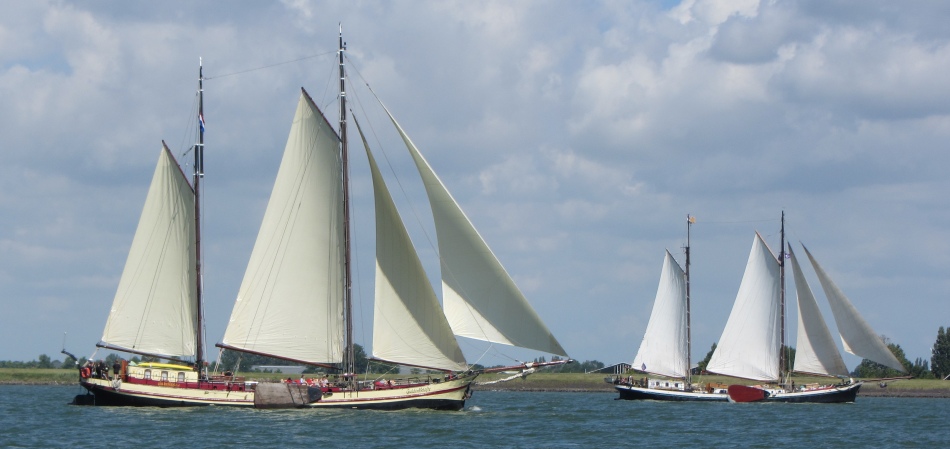 Two-masted Tallships heading from Hoorn to Enkhuizen |
 Cool Hand Rex hiding in the Shadows |
The event was marred when we started picking up traffic on the VHF radio. We detected that a rescue operation was taking place somewhere, involving three lifeboats and two helicopters. We picked up brief snatches of the conversations: "Can you see people in the water?", and "How much debris is in the water?" What had happened, where it was and what the outcome was we'll never know.
Eventually we reached the lock at Enkhuizen and dropped our sails. This lock was located at the western end of the Markerwaarddijk, and another lock lay at the eastern end of the dyke at Lelystad. The Markerwaarddijk separates the Markermeer from the Ijsselmeer, and acts as an insurance policy. Should the sea breach the Afsluitdijk at the northern end of the Ijsselmeer, the Markerwaarddijk would still serve to protect Amsterdam and other towns from flooding. There are actually two locks at Enkhuizen, one for commercial traffic and the other for leisure craft. We glided into the latter. Below us traffic traveling across the Markerwaarddijk sped along inside a tunnel.
Two large two masted tall ships were already in the lock, plus numerous other yachts. We moored up inside with ease. The two masted ships appeared to be training vessels full of school children.
The fun started as soon as the lock opened. One of the tall ships edged out, then a few yachts made a break for it, almost bouncing between the lock side and the tall ship. Why do some continentals go speed crazy around locks? The second tall ship started to pull out, and the Dutch boat in front of us started to edge forward, hoping to get in front of the tall ship. The yacht captain's wife cast off the ropes, but she also pulled the fenders up. The stern of the yacht started swinging to the side of the lock and the wife was now screaming that there was no longer a fender at the stern. Choice Dutch words passed between the pair, and they managed to rocket ahead unscathed. Benny Hill episodes, all of them.
We have noticed over the years that it is normally the German yachts that jostle to be at the front of the grid, almost fighting to be in the lead. Now the Dutch appear to have picked up the habit. Rex is laid back and just says, "After you old boy," to avoid this unnecessary hassle. I guess he picked this mode of operation from his constant reading of P. G. Wodehouse's Jeeves and Wooster. His viewpoint is, "There is no satisfaction to be gained from beating someone who is not competing."
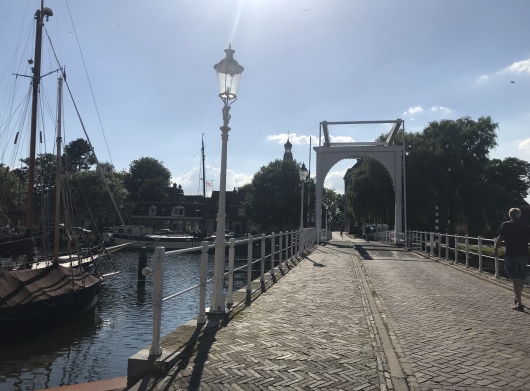 Rex Entering Enkhuizen |
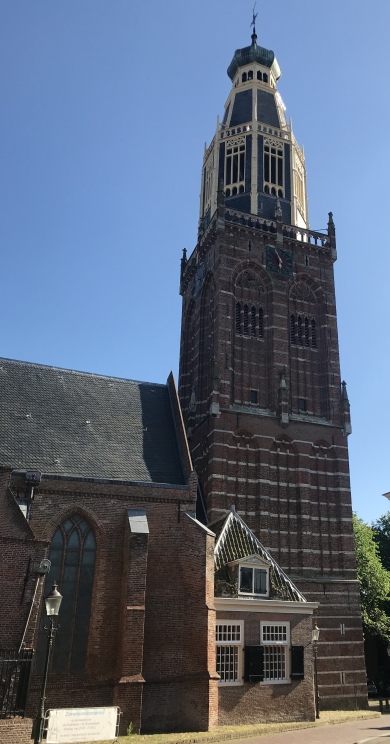 St Pancraskerk |
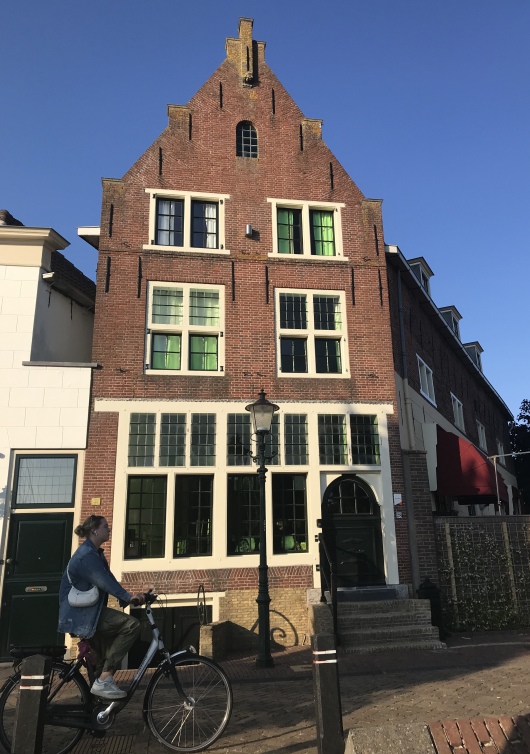 House on Dijk by Oude Haven |
The history of the East India Company, known as VOC, in Enkhuizen is still clearly visible. The VOC was in the 17th and 18th centuries the largest trading company in the world, and its magnificent ships travelled to Asian countries to trade. The convenient location on the Ijsselmeer made it attractive to settle here. A "Chamber of the VOC", the Drommedaris, the defence tower on the harbour, and the centre of the historic buildings, reminded us of this prosperous time.
We strolled past the imposing St Pancraskerk. The Zuider- or Sint-Pancraskerk is a two-aisled, late-Gothic hall church. The construction of the church, dedicated to the martyr Pancratius, must have started around 1423, after the inhabitants of Enkhuizen were given leave in 1422 by Duke Jan van Beieren to demolish the church outside the dyke in Oostdorp, which was flooded in 1421 and build a new church, to be built within the dyke. The church was largely completed in 1458. The tower is owned by the civil municipality of Enkhuizen and was restored in 1992. Ceiling paintings of Biblical scenes were painted in 1484, but they were painted over in 1609: after the Reformation, the church had fallen into the hands of the Protestants. It was only in the twentieth century that these paintings and some wall paintings were uncovered.
We discussed films, one of which I just could not remember the title of. Then we retraced steps we had taken with Richard in 2019 to one of the town canals. Here a family were leaping into the water, swimming, paddle boarding and generally having a good time, right next to the NO SWIMMING sign. The bars along Dijk by the Oude Haven were all packed. We picked our way back to Duonita, carefully avoiding all the joggers from a Bootcamp taking place on the green by the Drommerdaris.
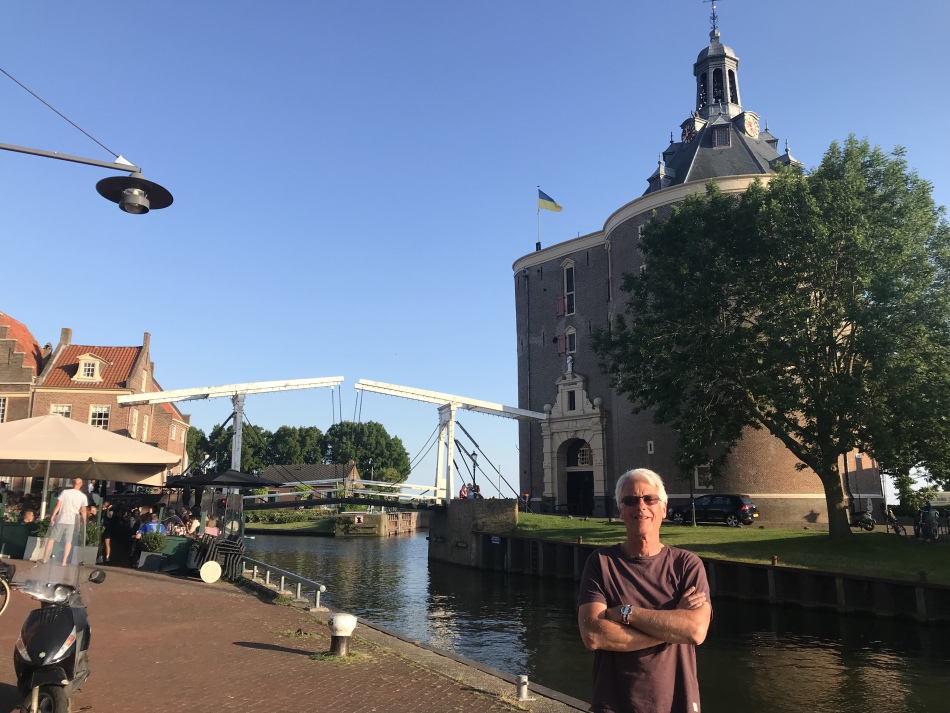 Mr Atlas Posing in front of the Drommerdaris |
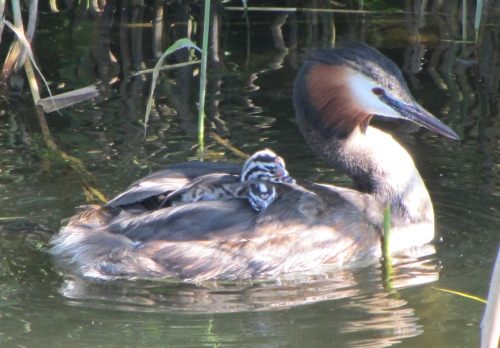 Grebe with Chick on her Back |
